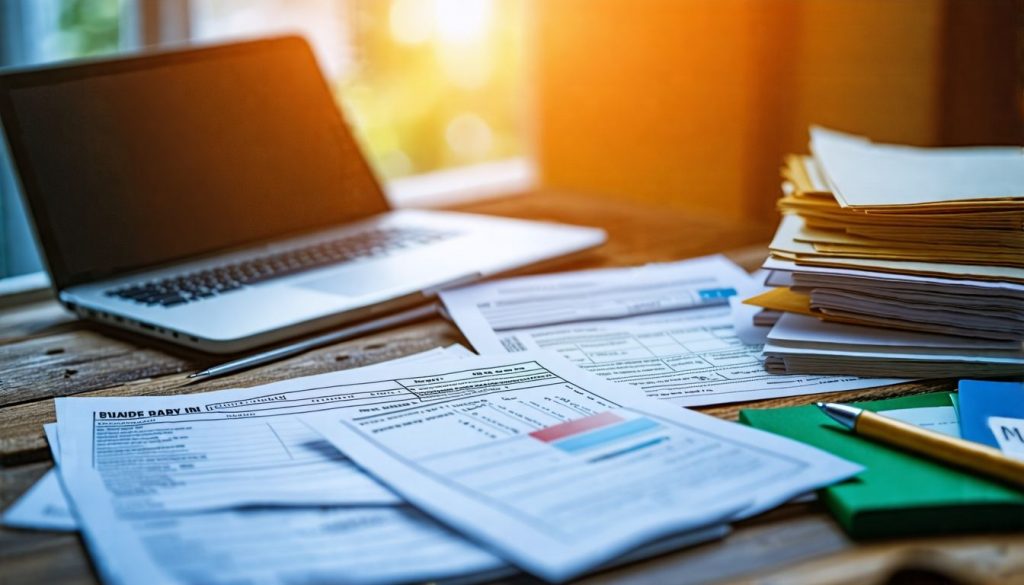Struggling with credit card debt is a common issue many Canadians face. A shocking fact: high-interest rates can turn even small debts into huge burdens over time. This article presents the best way to pay off credit card debt, offering four proven strategies for fast results.
Get ready for relief!
Key Takeaways
- Pay more than the minimum payment on your credit cards each month to reduce debt faster and save on interest.
- Use a budget to track spending, cut unnecessary expenses, and allocate more money toward paying off credit card debt.
- Consider consolidating multiple debts into one with a lower interest rate through balance transfers or personal loans to simplify payments.
- Stop using your credit cards and rely on cash or debit for purchases to prevent increasing your debt.
- Reach out to your credit card provider for assistance options like lower rates or flexible payment plans that can help manage debt better.
Understanding Credit Card Debt
Credit card debt can quickly pile up, making it tough to manage finances. High-interest rates contribute significantly to this burden, impacting your budget and overall financial health.
What is credit card debt?
Credit card debt arises when consumers make purchases using their credit cards and borrow money from a lender. This type of debt accumulates interest, which can significantly increase the total amount owed if not paid off promptly.
High-interest rates often make it challenging for Canadians to manage their balances effectively, leading to financial strain over time.
The credit utilization ratio plays a crucial role in personal finance management. It reflects the percentage of available credit being used and affects your credit score directly. Maintaining a lower ratio is essential for improving overall financial health and reducing the burden of credit card debt.
Understanding these fundamentals sets the stage for exploring effective strategies to pay off what you owe.
Impact of high-interest rates
High-interest rates significantly impact credit card debt repayment for Canadians. With average interest rates often exceeding 19%, the cost of borrowing can accumulate quickly. This means that for every dollar you charge, a substantial portion goes toward interest rather than reducing your principal balance.
Over time, this erodes your ability to pay off debts effectively and can lead to a cycle of increasing balances.
Understanding how these high rates affect your finances is crucial for managing credit card debt successfully. As bills pile up with interest accruing monthly, it becomes essential to implement effective credit card repayment strategies.
By acknowledging the weight of high-interest charges, you can take proactive steps in budgeting and prioritizing payments to avoid falling deeper into debt.
Credit utilization ratio
The credit utilization ratio plays a significant role in determining your credit score. This ratio measures how much of your available credit you are using at any given time. A lower percentage indicates responsible credit management, while a higher percentage can negatively impact your score and suggest financial strain.
To maintain a healthy ratio, aim to keep it below 30%. For example, if you have a total credit limit of $10,000 across all cards, try not to exceed $3,000 in total debt. Effective credit card debt payment strategies involve monitoring this ratio closely and paying down balances promptly to improve your financial health.
Keeping track of your spending will support overall debt reduction efforts and enhance your chances for faster results in eliminating credit card debt.
Strategies for Paying Off Credit Card Debt
To tackle credit card debt effectively, you need a solid plan. Focusing on one debt at a time can lead to quicker results and keep you motivated as you see progress.
Review and revise your budget
Creating a solid budget is vital for paying off credit card debt. It helps you see where your money goes and what changes you can make to eliminate those balances faster.
- Track your spending: Start by recording all your expenses for a month. This includes everything from groceries to entertainment. Use apps or spreadsheets to help organize this information clearly.
- Categorize expenses: Divide your spending into fixed and variable costs. Fixed costs, like rent and utility bills, stay the same each month. Variable costs, such as dining out or shopping, can be adjusted based on your financial goals.
- Identify unnecessary expenses: Look through your variable costs and find areas where you can cut back. Cancel subscriptions you don’t use or limit dining out to save more money for paying off credit card debt.
- Set realistic goals: Establish clear financial targets for yourself monthly. Decide how much you want to pay towards debt repayment each month alongside necessary living expenses.
- Allocate funds wisely: After identifying needs versus wants, ensure that you’re directing enough money toward debt reduction methods in your budget each month. Prioritize making more than the minimum payment on your credit cards.
- Review regularly: Check-in on your budget often, at least once a month. Adjust it as needed if any new expenses arise or if you want to increase payments towards eliminating credit card debt even quicker.
- Stay disciplined: Stick with this budgeting plan so that it becomes a routine part of managing your finances effectively over time. This discipline will help you achieve faster results when paying off credit card balances.
- Seek professional advice if needed: If budgeting seems overwhelming, consider talking to a financial advisor or using free resources offered by non-profits about debt management tips in Canada.
Utilizing these steps will enhance your overall financial planning for debt reduction and lead you closer to a state of being debt-free living.
Make more than the minimum payment each month
Making more than the minimum payment each month is crucial for effective credit card debt management. Minimum payments only cover interest and a small portion of the principal, prolonging your repayment period significantly.
By paying extra, you can reduce both your balance and the amount of interest paid over time. This strategy accelerates debt payoff and helps you save money in the long run.
Consider setting a specific goal for how much extra to pay each month. Even an additional $50 or $100 can make a significant difference. It enables quicker credit card debt elimination by decreasing your overall debt faster while also improving your credit utilization ratio—a key factor in maintaining good credit health.
Prioritize this method as one of the fastest ways to eliminate credit card debt effectively.
Target one debt at a time
Focusing on one debt at a time can significantly streamline your efforts to eliminate credit card debt. This strategy, often referred to as the “debt snowball” or “debt avalanche,” allows you to pay off smaller debts first for quick wins or target higher-interest debts for greater savings over time.
Choose the approach that aligns with your financial goals and motivates you most.
By concentrating your resources on a single debt, you not only simplify payments but also build momentum towards becoming debt-free. For instance, if you have multiple credit cards, prioritize one while making minimum payments on others.
This method enhances cash flow and reduces stress associated with juggling multiple debts simultaneously. Accelerated debt payoff becomes more achievable when you maintain focus on individual obligations rather than spreading too thin across various accounts.
Consolidate debt with loans or balance transfers
Consolidating debt can streamline your payments and save on interest. Consider options like personal loans or balance transfers to combine multiple debts into a single one, offering lower monthly payments.
Many credit card companies provide promotional offers for balance transfers with low or zero interest rates for an introductory period. This approach allows you to tackle credit card debt more effectively by reducing the overall cost of repayment.
These strategies often lead to faster results in eliminating high-interest debts. Explore different loan options and find a balance transfer that fits your financial situation well before making a decision.
Next, consider practical tips that will help drive you toward quicker debt repayment success.
Tips for Fast Results
To see quick results, stop using your credit cards. Focus on making extra payments to reduce your debt faster.
Stop using credit cards
Stopping the use of credit cards is essential for Canadians looking to pay off debt quickly. Each swipe adds to your existing balance and increases your financial burden. Focus on using cash or debit instead, which allows you to manage spending better while working towards credit card debt elimination techniques.
This discipline prevents further accumulation of interest charges, which can escalate rapidly due to high-interest rates.
Creating a budget that restricts non-essential purchases will also help reinforce this commitment. Prioritize saving money and directing any extra funds toward your outstanding debts.
Developing these habits contributes significantly to achieving debt-free living strategies in the long run. Hold yourself accountable by tracking progress regularly, ensuring each payment takes you closer to financial freedom.
Make extra payments
Making extra payments can significantly reduce your credit card debt. Paying more than the minimum each month lowers your balance faster and reduces interest charges over time. Canadians should consider using any extra cash from bonuses, tax refunds, or side jobs to make these payments.
Even a small amount can add up quickly, leading to substantial savings in interest.
These additional repayments not only shorten the payoff period but also improve your overall credit card management. By regularly making extra contributions toward your debt, you will gain momentum in paying off debt quickly while moving closer to a debt-free living lifestyle.
Consider other sources to pay off debt
Exploring different sources for debt repayment can speed up your journey to becoming debt-free. Canadians have several options at their disposal.
- Personal Loans: A personal loan can provide you with a lump sum to pay off credit card debt. Interest rates on personal loans are often lower than credit card rates, allowing you to save money over time. Many banks and credit unions offer competitive rates, so shop around for the best deal.
- Home Equity Line of Credit (HELOC): If you own a home, consider using a HELOC. This option allows you to borrow against your home’s equity. HELOCs typically have lower interest rates compared to credit cards, making them an attractive choice for those looking to consolidate debt.
- Government Grants and Assistance Programs: Some provinces in Canada offer financial assistance for managing debt through grants or programs aimed at reducing financial burdens. Investigate local options that may provide funding or resources tailored to help individuals facing significant debt issues.
- Borrowing from Family or Friends: Communicating with trusted family members or friends about your situation can lead to support. They might be willing to lend you money at a lower interest rate than what you’re currently paying on credit cards, giving you a breathing space while paying off debts.
- Side Jobs and Extra Income: Taking on side gigs can significantly increase your income. Consider part-time work, freelancing, or selling unused items online. This extra money can go directly towards your credit card payments, speeding up the repayment process.
These alternatives provide various pathways for effective credit card debt management. Next, we will explore vital tips for achieving fast results in reducing your overall debt load.
Contact your credit card provider
Reaching out to your credit card provider can be a helpful step in managing your debt more effectively. Many issuers offer assistance programs that may include lower interest rates or flexible payment plans for struggling customers.
These options can significantly ease the burden of credit card debt and help you develop a personalized strategy for repayment.
Communicating with your provider shows initiative in addressing financial challenges. They might have solutions that align with your needs, such as hardship programs or promotional balance transfer offers.
Taking this proactive approach is essential to maximizing your potential for quick debt payoff and fosters better money management habits moving forward.
Conclusion
Using the right strategies can make a significant difference in paying off credit card debt. Implementing these methods will help accelerate your journey to financial freedom. Commit to making smart choices with your budget, and don’t hesitate to seek support if you need it.
A proactive approach today paves the way for a debt-free tomorrow. Embrace these proven techniques and take control of your financial future.
FAQs
1. What are some fast debt repayment tips to reduce credit card debt?
Fast debt repayment tips include strategies like paying more than the minimum payment, using government assistance with debt relief, and considering a method called debt consolidation.
2. How does a strategy for quick debt payoff work?
Strategies for quick debt payoff involve creating a budget plan that focuses on reducing your spending while increasing payments towards your credit card debts.
3. Can you share any proven methods of credit card debt management?
Proven methods of managing credit card debts include making timely payments, avoiding unnecessary purchases, and seeking help from professional financial advisors to live debtfree.
4. Are there ways to achieve debtfree living faster?
Yes! Utilizing government assistance programs or adopting proven strategies such as consolidating all your debts into one manageable payment can expedite the process towards achieving debtfree living.








